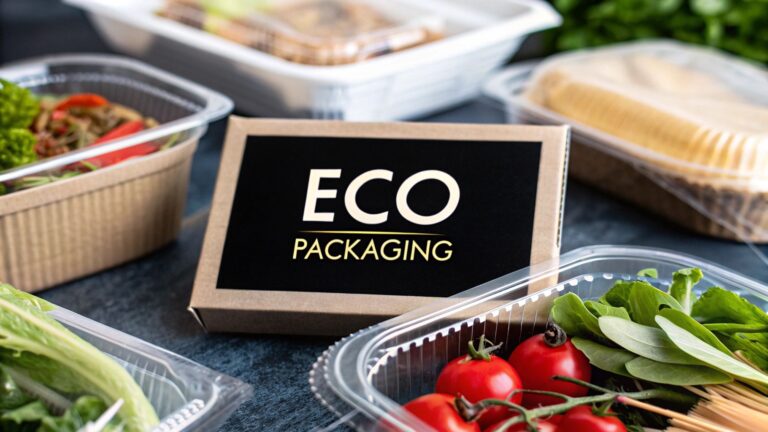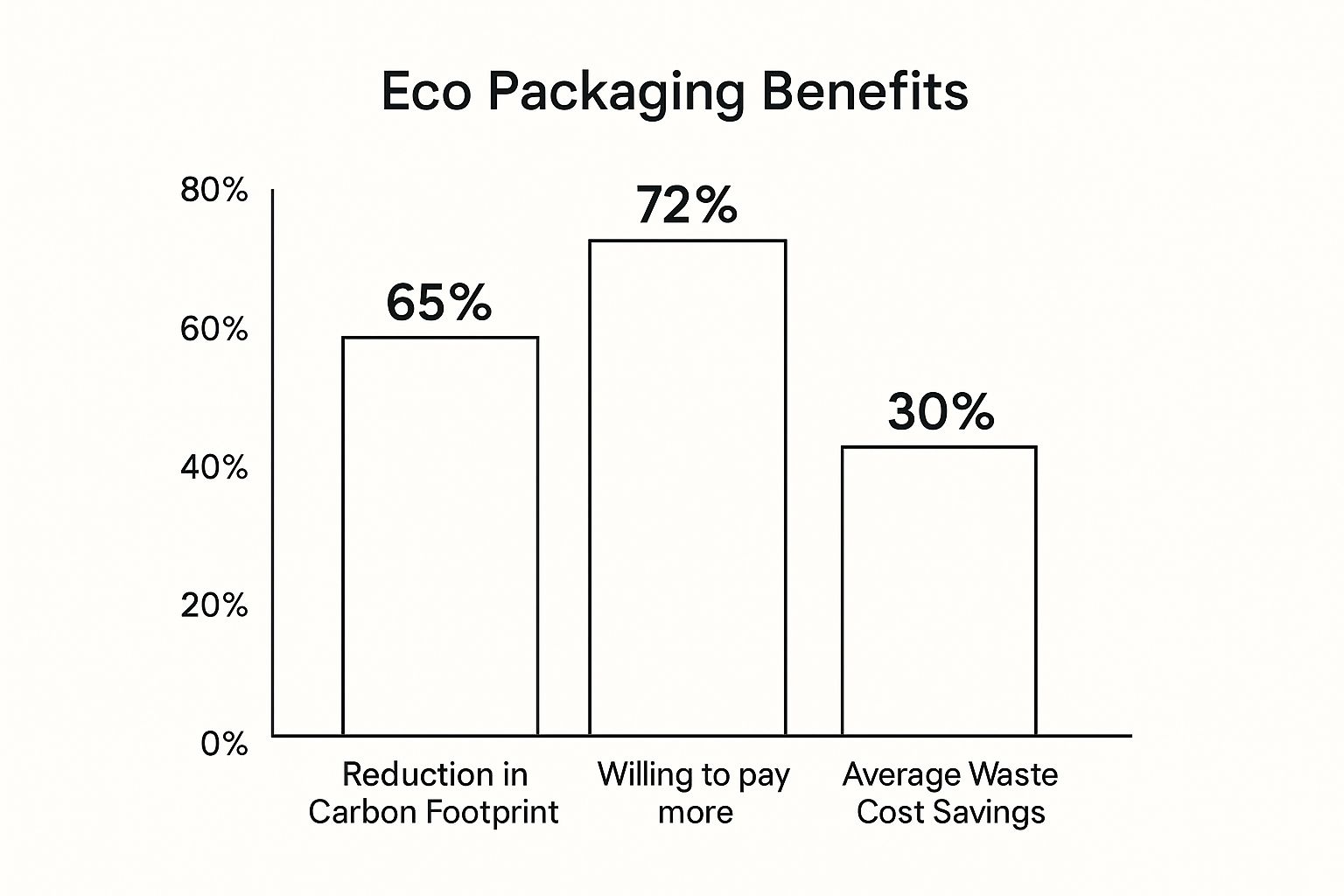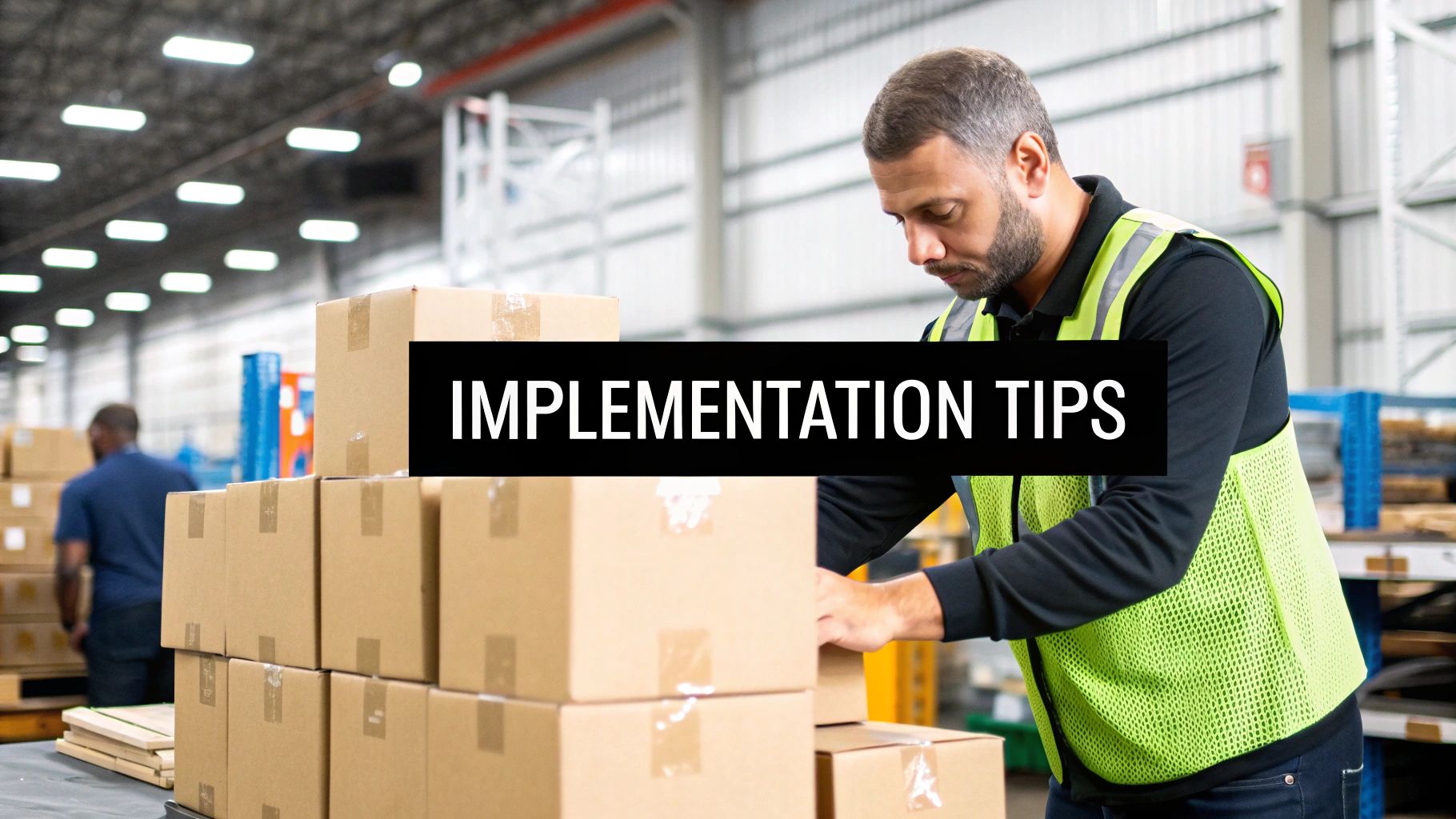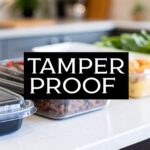The Sustainable Packaging Revolution Reshaping Food Brands
The food industry is changing. Packaging is no longer just about practicality; it’s a key part of a brand’s identity and environmental commitment. This move towards eco-friendly food packaging is a significant shift in how food brands operate and engage with their customers. It reflects a growing global understanding of the environmental impact of traditional packaging and a desire for more sustainable choices.
Consumer Demand and Brand Identity
A major driver of this change is consumer demand. Customers are increasingly aware of the environmental impact of their purchases. They’re actively looking for products from companies that align with their values.
This makes eco-friendly packaging a powerful way for brands to stand out. Brands prioritizing sustainability are seen as responsible and innovative, building stronger customer loyalty.
For example, consider two pasta sauce brands. One uses a standard plastic jar; the other opts for recycled glass. The environmentally conscious consumer is more likely to choose the recycled glass, even at a slightly higher price. This demonstrates the influence of sustainable packaging on buying decisions and brand image.
Market Growth and Innovation
The market for eco-friendly food packaging is booming. In 2020, it was valued at USD 174.7 billion. Projections anticipate growth to USD 249.5 billion by 2025, a CAGR of 7.4%. This growth reflects rising consumer awareness of the environmental impact of materials like plastic, prompting a shift toward sustainable alternatives.
Technological advancements in packaging materials, such as active and antimicrobial packaging, have also contributed to this expansion. Government regulations and bans on single-use plastics in many countries are further pushing the adoption of eco-friendly options. These regulations, along with changing consumer expectations, are creating a whole new landscape for food packaging.
The Future of Food Packaging
This trend is set to continue as consumers become even more environmentally aware. This demand for sustainable solutions is driving innovation, leading to the development of new materials and designs.
Businesses that adapt to these market changes will be best positioned for success. This includes exploring alternatives to traditional materials and embracing a circular economy, where materials are reused and recycled. The sustainable packaging revolution is reshaping the food industry, presenting both challenges and exciting opportunities for businesses.
Breakthrough Materials Revolutionizing Food Containment
The infographic above illustrates the advantages of using eco-friendly food packaging. It highlights the significant impact on carbon footprint reduction, the increasing consumer demand for sustainable choices, and the substantial cost savings on waste management. Embracing these practices benefits the environment and appeals to environmentally conscious consumers.
This translates to a 65% reduction in carbon footprint, with 72% of consumers willing to pay more for sustainable packaging. Companies also see an average of 30% cost savings on waste management. This clearly shows the combined benefits of environmental responsibility, consumer appeal, and financial advantages.
Biodegradable Polymers: A Sustainable Solution
Biodegradable polymers offer similar functionality and durability to traditional plastics, but with a crucial difference: they break down naturally. This helps eliminate the persistent pollution problem associated with conventional plastic packaging.
A prime example is polylactic acid (PLA), derived from renewable resources like cornstarch. PLA is commonly used in food containers and films, offering a practical alternative to petroleum-based plastics. This shift towards biodegradable materials represents a significant step towards sustainable packaging.
Plant-Based Alternatives: Nature’s Packaging
Plant-based materials are gaining popularity as another sustainable food packaging option. Materials like bamboo, sugarcane bagasse, and mushroom packaging provide renewable and compostable alternatives. These materials are often lightweight, which reduces transportation emissions and overall environmental impact.
Furthermore, using plant-based packaging can enhance a brand’s image by demonstrating a commitment to sustainability. This can attract environmentally conscious consumers and strengthen brand loyalty.
Edible Packaging: The Future of Zero-Waste
Edible films and coatings represent a truly innovative approach. These materials can be consumed along with the food, completely eliminating packaging waste. Imagine edible seaweed wrappers for sushi or gelatin-based coatings for produce.
This not only reduces waste but can also enhance the flavor or nutritional value of the food. While still an emerging technology, edible packaging holds great promise for a zero-waste food system. Further research and development will likely lead to exciting new options in the near future.
To help understand the different options available for eco-conscious businesses, the following table provides a comparison of various materials.
Comparison of Eco-Friendly Packaging Materials
| Material Type | Biodegradability | Moisture Resistance | Cost Factor | Best Food Applications | Environmental Impact |
|---|---|---|---|---|---|
| PLA (Polylactic Acid) | High | Moderate | Moderate | Food containers, films | Lower than traditional plastic |
| Bamboo | High | Moderate | Moderate | Dry goods, takeout containers | Very Low |
| Sugarcane Bagasse | High | Moderate | Low | Takeout containers, plates | Very Low |
| Mushroom Packaging | High | Low | High | Protective packaging for fragile items | Extremely Low |
| Seaweed | High | Low | Moderate | Wraps, edible films | Extremely Low |
| Gelatin | High | Low | Low | Edible coatings | Low |
Key takeaways from the table include the very low environmental impact of bamboo and sugarcane bagasse, the potential of seaweed and gelatin for edible packaging, and the versatility of PLA for various food applications.
Each material presents unique benefits and limitations, highlighting the importance of choosing the right material based on specific product needs and sustainability goals.
Market Transformation: Growth Drivers and Opportunities
The shift toward eco-friendly food packaging is more than a fleeting trend; it signifies a profound market transformation. This shift is propelled by powerful forces and offers substantial opportunities for businesses willing to adapt. Understanding the key growth drivers is crucial for companies aiming to succeed in this evolving market.
Regional Adoption and Investment Trends
The adoption of eco-friendly packaging varies considerably across different regions. Europe, for example, often leads with stringent regulations and high consumer demand, while other areas are catching up. This creates distinct regional markets and opportunities for specialized packaging solutions. Businesses operating internationally must grasp these regional differences.
Investment in sustainable packaging technologies is also increasing, demonstrating the growing significance of this sector. This investment drives innovation, leading to the development of new materials and more efficient production methods. This influx of capital further propels market growth and generates exciting prospects for investors and innovators.
Growth Hotspots and Emerging Innovations
Some packaging segments are experiencing remarkable growth. Compostable packaging for takeout and delivery services, for instance, is expanding rapidly due to rising consumer demand for both convenience and sustainability. Companies providing innovative solutions in these high-growth areas have the potential to gain significant market share.
New market categories are also appearing. The increasing demand for plant-based foods, for example, often aligns with a preference for plant-based packaging. This creates a niche market for materials derived from renewable sources such as bamboo or sugarcane bagasse. This interconnectedness highlights the dynamic interplay of various market trends within the food industry.
Consumer Behavior and Shifting Retail Landscapes
Changing consumer behavior plays a vital role in this market transformation. Consumers increasingly base purchasing decisions on a brand’s environmental commitment. Eco-friendly packaging is no longer a niche preference, but rather a mainstream expectation.
The retail landscape is adapting to these shifts. Major retailers are increasingly prioritizing sustainable packaging in their product offerings and store operations. This creates a ripple effect throughout the supply chain, prompting more brands to embrace environmentally sound practices. Sustainability is becoming a core business strategy rather than simply a marketing tactic.
Furthermore, the global eco-friendly food packaging market is demonstrating substantial growth. Reaching USD 199.99 billion in 2024, it’s projected to reach USD 392.37 billion by 2034, exhibiting a CAGR of 6.97% from 2025 to 2034. This growth is driven by factors like increased environmental awareness and stricter regulations on single-use plastics. This expansion provides significant opportunities for businesses that can adapt to these evolving consumer demands and offer truly sustainable packaging solutions.
The Business Advantage: Beyond Environmental Benefits
Eco-friendly food packaging is more than a passing trend; it’s a smart business move. Protecting the planet is essential, of course, but sustainable packaging also offers real financial benefits that can boost a company’s profits. This approach transforms packaging from a simple cost into a valuable asset that fuels growth and improves a brand’s image.
Consumer Loyalty and Premium Pricing
Today’s consumers are increasingly environmentally aware, actively seeking out brands that align with their values. A remarkable 72% of consumers are willing to spend more for products packaged sustainably, demonstrating the impact of eco-conscious choices. This willingness to pay a premium allows businesses to position their products as higher quality and, ultimately, more desirable.
By opting for eco-friendly packaging, brands build trust and cultivate loyalty with this growing consumer base. This translates into repeat customers and positive word-of-mouth marketing, further enhancing profitability. Imagine a bakery switching to compostable boxes: they might attract environmentally conscious customers who value the bakery’s commitment to sustainability.
Reduced Operational Costs and Waste Management
While the upfront investment in sustainable materials might appear higher, long-term operational costs can actually decrease. Lightweight packaging, for example, reduces shipping costs. Similarly, reusable or recyclable materials minimize waste disposal fees, resulting in substantial savings over time.
Companies experience an average of 30% cost savings on waste management by incorporating sustainable practices. This highlights the financial advantages of reducing, reusing, and recycling within a business framework. Think about a catering service switching to reusable containers: this eliminates the need for disposable packaging, saving money on materials and waste removal.
Enhanced Brand Storytelling and Marketing
Eco-friendly packaging serves as a powerful storytelling medium. It communicates a brand’s values and dedication to sustainability, resonating with environmentally aware consumers. This narrative strengthens brand image and creates a positive connection with customers.
This positive perception becomes a competitive advantage. In a crowded marketplace, sustainable packaging distinguishes a brand and attracts customers who prioritize environmental responsibility. This differentiation can be the deciding factor for consumers choosing between similar products.
Measuring ROI and Competitive Analysis
Evaluating the return on investment (ROI) of sustainable packaging goes beyond simple cost comparisons. It requires calculating the long-term financial gains from reduced waste, increased customer loyalty, and a stronger brand reputation.
Competitive analysis reveals how sustainable packaging positions a brand in the market. Businesses that embrace these practices often gain a competitive edge by appealing to customers seeking eco-friendly choices. This reinforces the importance of integrating sustainability into a company’s core business strategies.
Practical Implementation: From Strategy to Reality
Switching to sustainable packaging requires a well-defined strategy and flawless execution. This section offers practical guidance for food businesses of all sizes, from those just starting their sustainability journey to those already making strides.
Conducting a Packaging Audit
The first step towards eco-friendly food packaging is understanding your current practices. A thorough packaging audit helps analyze existing materials, waste production, and potential improvements. This audit establishes a baseline, highlighting areas where changes make the biggest difference.
For instance, a restaurant might discover that takeout containers are a major source of waste. This allows them to focus on sustainable alternatives like compostable containers. By understanding the current situation, businesses can target their efforts effectively.
Evaluating Alternative Materials
Once the current usage is clear, exploring alternative materials becomes the next step. Consider factors like food type, shelf-life needs, and distribution methods. The broader environmental impact of source materials like hemp is also crucial.
Packaging oily foods requires materials with excellent moisture and grease barriers. For long-distance shipping, durability is paramount to protect contents during transit. Choosing the right material ensures both product integrity and environmental responsibility.
Managing Supplier Relationships
Transitioning to eco-friendly packaging often involves new suppliers. Building solid relationships with these partners is crucial. Openly communicate your needs, lead times, and quality standards.
This proactive communication ensures a smooth transition and successful implementation of new materials. Strong supplier relationships are essential for maintaining a consistent supply of sustainable packaging.
Communicating Changes to Customers
Transparency with customers is key when changing packaging. Clearly explain the benefits of the new eco-friendly packaging, highlighting its positive environmental impact. Communicate any functional improvements or enhanced product preservation.
This openness builds customer understanding and support. A simple message on your packaging or website explaining the switch to recycled materials, for example, can foster positive customer engagement.
Developing Timelines and Budgets
A realistic timeline and budget are fundamental for successful implementation. Break down the process into phases with clear milestones and deliverables. This structured approach facilitates progress tracking, cost management, and staying on schedule.
Starting with a single product line’s transition to sustainable packaging before scaling up to the entire product range is a practical strategy. This measured approach minimizes disruption and allows for adjustments along the way.
Measuring Success
Defining key performance indicators (KPIs) is vital for assessing the effectiveness of your sustainability efforts. These metrics might include waste reduction, cost savings, or improved customer satisfaction.
Tracking these indicators helps measure progress, identify areas for refinement, and demonstrate the tangible impact of your sustainable practices. Regular monitoring ensures that your initiatives are achieving their intended goals.
To help visualize the process, the following table provides a detailed timeline for implementing eco-friendly food packaging:
Eco-Friendly Packaging Implementation Timeline
| Implementation Phase | Key Activities | Timeline | Resource Requirements | Success Metrics |
|---|---|---|---|---|
| Assessment | Conduct packaging audit; Analyze current materials and waste | 1-2 Months | Internal team, consultant (optional) | Baseline data on packaging usage and waste |
| Material Evaluation | Research and test eco-friendly alternatives; Assess material compatibility and performance | 2-3 Months | Material samples, testing facilities | Material performance data, cost comparisons |
| Supplier Selection | Identify and vet sustainable packaging suppliers; Negotiate contracts and pricing | 1-2 Months | Supplier directory, legal counsel | Supplier reliability, material availability |
| Implementation | Pilot test new packaging; Update production processes and labeling | 3-6 Months | Production team, marketing team | Packaging performance in real-world conditions |
| Evaluation and Refinement | Track KPIs; Gather customer feedback; Adjust packaging strategy as needed | Ongoing | Data analytics tools, customer surveys | Waste reduction, cost savings, customer satisfaction |
This table offers a practical framework for implementing eco-friendly food packaging. From initial assessment to continuous evaluation, each phase has defined activities, timelines, and resources. The included success metrics help track progress and ensure alignment with your sustainability objectives.
Next-Generation Innovations Reshaping Consumer Expectations
The world of eco-friendly food packaging is constantly evolving. New technologies and changing consumer preferences are reshaping what we expect from food packaging and how brands meet those expectations.
Beyond Biodegradability: Smart and Active Packaging
Biodegradable materials are essential, but the future of eco-friendly packaging goes further. Smart packaging, for example, uses technology to improve food safety and reduce waste. Imagine a package that changes color to indicate spoilage. This visual cue informs consumers about freshness, reducing waste, and building trust.
Active packaging interacts with food to extend shelf life. This might involve absorbing excess moisture or releasing preservatives, keeping food fresher for longer, and minimizing the need for artificial additives. This appeals to health-conscious consumers.
Antimicrobial Coatings: Natural Protection
Consumers are demanding natural and clean-label products, impacting packaging innovation. Antimicrobial coatings derived from natural sources like essential oils or plant extracts can inhibit bacterial growth. This offers a natural alternative to synthetic preservatives, aligning with consumer preferences.
Enhanced Functionality and Convenience
Consumers expect eco-friendly packaging to be just as convenient as traditional options. Innovations like resealable pouches made from compostable materials or easy-open features on recycled cardboard deliver on this. Sustainability and convenience can go hand in hand.
Aesthetics: Eco-Friendly and Eye-Catching
Visual appeal remains crucial. Consumers are drawn to attractive packaging that reflects their values. This has fueled innovative designs using recycled materials, plant-based inks, and minimalist aesthetics. Eco-friendly packaging is now a statement about a brand’s commitment to sustainability.
The global market for eco-friendly food packaging is growing rapidly. In 2025, the market was valued at USD 274.21 billion. By 2029, it’s projected to reach USD 408.44 billion, a CAGR of 10.5%. This growth is driven by innovations in biodegradable and compostable packaging, smart packaging solutions, and increasing consumer demand. This presents significant opportunities for companies investing in sustainable packaging.
The Future of Eco-Friendly Packaging
These innovations are transforming consumer expectations and shaping the future of the food industry. Brands that prioritize both sustainability and the consumer experience will thrive. Combining functionality, convenience, and attractive design with environmentally sound practices creates packaging that resonates with consumers and contributes to a more sustainable future.
Your Sustainable Packaging Roadmap: Actionable Next Steps
Transforming your food packaging into a truly eco-friendly system requires a well-defined plan. This section offers a structured approach, breaking down key strategies and implementation steps into practical advice. This allows you to achieve both short-term gains and make long-term, positive changes for the environment and your business.
Initial Assessment and Goal Setting
First, thoroughly evaluate your current packaging practices. What materials are you using? How much waste are you generating? A comprehensive audit provides a baseline for measuring progress and pinpointing areas for improvement. For example, are your current takeout containers recyclable or compostable? This initial assessment highlights where changes will yield the greatest impact.
Next, establish clear sustainability goals. Are you aiming for a specific percentage reduction in plastic use? Do you want to transition to entirely compostable materials? Setting measurable objectives gives you direction and helps you track progress. You might be interested in: Help to Survive the Holiday Season.
Material Selection and Supplier Collaboration
Once you’ve defined your goals, research and evaluate eco-friendly packaging alternatives. Consider factors like product compatibility, shelf life, and transportation needs. For instance, if you package liquids, you’ll need materials with excellent moisture barriers.
Collaborating with reputable suppliers who specialize in sustainable materials is crucial. Open communication ensures a consistent supply of high-quality, eco-friendly packaging that aligns with your specific needs. This partnership can also offer valuable insights into new materials and emerging technologies.
Implementation and Communication
Begin with a pilot program, perhaps transitioning one product line to the new packaging before expanding. This allows you to refine processes and address any unexpected issues. For instance, you might need to adjust your production line or update your labeling procedures.
Communicating clearly with your customers about these changes is vital. Emphasize the environmental benefits of your new packaging and any enhancements in functionality or product preservation. This builds trust and cultivates a positive view of your brand’s dedication to sustainability.
Continuous Improvement and Adaptation
The journey towards sustainable packaging is an ongoing process. Regularly monitor your progress toward your established goals, gathering feedback from both your team and your customers. Are you hitting your waste reduction targets? Are customers happy with the new packaging?
Stay informed about emerging technologies and changing consumer preferences. The world of eco-friendly packaging is constantly evolving, with new materials and innovations emerging regularly. This means continuous adaptation and refinement of your packaging strategy is critical for lasting success. Being proactive and informed will keep your business at the forefront of sustainable packaging practices.
Ready to enhance your brand with sustainable packaging? Visit MrTakeOutBags.com for a wide selection of eco-friendly takeout packaging options designed for your business needs.







Comments are closed.